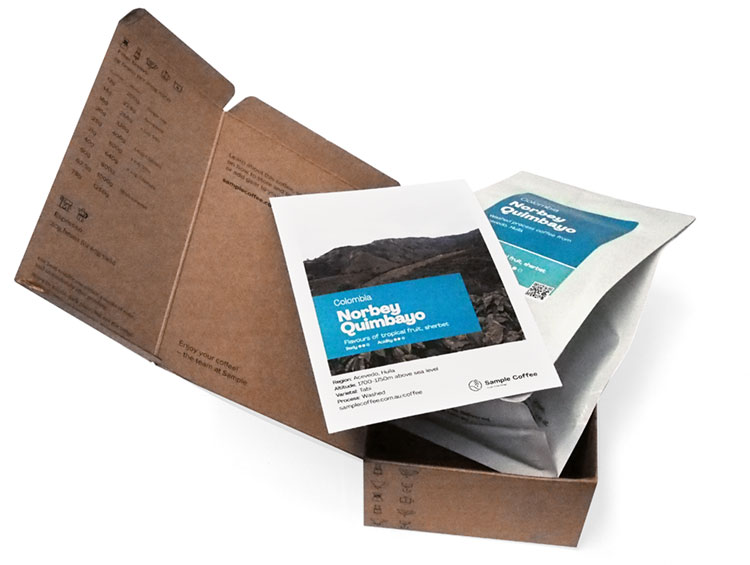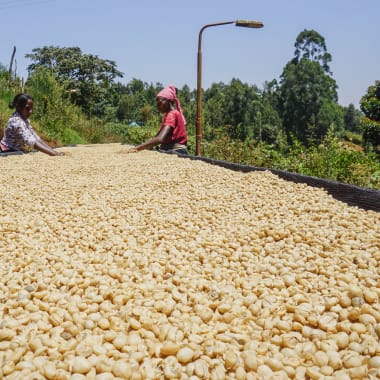-
Producer
-
María Del Rosario Olaya
-
Country
- Colombia
-
Region
-
Planadas, Tolima
-
Altitude
-
1800m above sea level
-
Variety
-
Process
-
Harvested
-
October 2015
-
Importer
-
Silo
-
Body
-
Medium
-
Acidity
-
Balanced
-
Tasting notes
-
Crisp green grape, butterscotch
-
Roast style
Colombia
Maria Del Rosario Olaya
With this delivery we’re enjoying another Colombian micro lot, this time from the farm Miro Lindo, and grown by María Del Rosario Olaya.
María washed the crop of caturra beans for eighteen hours before drying them on raised beds for around twenty days.
In many ways, this coffee has a similar story to that of Cesar Aroca: it’s from Colombia’s Tolima region; comes from the Coagrivida cooperative; and is from a similar altitude and approach to farming.
This story in Forbes, while focused on the Cauca region (south-west of Tolima) still covers plenty of great background on the challenges (and recent success) of Colombian specialty coffee growing.
Temperature and flavour
All coffees change in flavour profile as they cool down, but we’ve found this one’s range is particularly interesting.
When tasted hot, there’s big tropical flavours of green grape and guava. Then as it cools, we’ve noticed the flavours shifted towards butterscotch.
With temperatures at either extreme of hot or cold, your taste buds are less able to detect flavour, so it’s always interesting to taste your coffee as it cools (or try tasting gelato as it warms).
There’s some more discussion of temperature and flavour in the comments of James Hoffmann’s blog and also his original post.
The Guardian also has an interesting story on serving temperature and the flavour of food.
Coffee farming in Planadas, Tolima
Planadas, the town where the Coagravida cooperative is based, is shown in the photo for this coffee.
Planadas is the southernmost municipality of Tolima. It sits in the eastern slopes of Colombia's central cordillera, above the Magdalena River Valley, and boasts average temperatures of 20ºC.
Much of the coffee farming in this area takes place in partial shade, often provided by güamo (ice cream bean), nogal cafetero (Spanish Elms) and cacao.
Planadas has found itself at the centre of ongoing civil unrest, with Colombian militant group FARC’s famed stronghold Las Hermosas nearby, Planadas is often unreachable to outsiders.
FARC were in the news again this week, as a planned peace deal with the Colombian government delayed another two weeks.
Learn everything about this coffee:
Ethical, traceable sourcing
This page has all the sourcing information (variety, process, region, story, importer, and more) that our importers share with us, and give us permission to use.
The transparency helps us talk confidently about the quality and background of our product, and it helps you know exactly what you’re buying.
Learn more:
Coffee page transparency legend
Our coffee philosophy
Our business approach
Fresh harvest coffee
We only source and roast coffee from each country’s latest harvest season (so the green coffee is never older than 1 year from the time of picking, processing and packing). This ensures the sensory qualities are always at their peak and unaffected by excessive ageing.
Roasted for espresso and filter (best enjoyed black)
Roast style: omni. Omni roasts are designed to brew and taste great both as espresso and filter. Our omni single origins generally sit on Agtron values in the ~70-60 value range. So, technically, they are somewhere in the lighter side of the medium spectrum.
Designed for espresso and filter brewing. Best enjoyed black.
Learn more:
Our Loring Kestrel S35 roaster
Our roasting style and approach
Best brewed within days 15-49 post-roast
The ‘fresh is best’ saying doesn’t apply to coffee (contrary to popular belief). Waiting before opening and brewing your bag of whole coffee beans helps develop peak flavour and acidity.
But heads up: if you buy pre-ground coffee, brew it as soon as possible.
Learn more:
Our recommended brewing window
Try our custom brewing recipes
Our recipes and ratios are tailored to our coffee sourcing and roasting styles, bringing the best flavour and feel out of each coffee.
For pour over, immersion, and other filter brewing styles, check our brew guides.
For our espresso single origins, we recommend a coffee:yield ratio of 1:3:
- Dose: 20g ground coffee
- Yield: 60g espresso
- Total brew time: ~24-28 seconds
This is just a starting point! We encourage you to experiment, taste, and adjust to find the recipe that you enjoy the most.
Learn more:
Our espresso brew guide (single origin)
Brewing ratio calculator
Packaging and sustainability
- Bags: ABA-certified home compostable (AS 5810-2010)
- Labels: recyclable
- Valves (only on +250g bags): general waste
- Box and tape (online orders): recyclable
Learn more:
Our packaging
Variety
Caturra variety
Caturra is a natural mutation of Bourbon that was originally discovered in Brazil in 1937, considered to be the first naturally occurring mutation ever discovered.
The location
Coffee from Colombia
Colombia is one of the largest coffee producers in the world and benefits greatly from having one of the most unique and complex set of micro-climates of all coffee producing nations.
The Tolima region of Colombia
The word ‘Tolima’ comes from the local indigenous language and means a “river of snow or cloud”.
Farm processes
Washed, Dried On Raised Beds process
Machines are used to remove the flesh from the coffee cherry before being fermented in water, washed again, and finally sun dried. This process tends to result in more distinct, cleaner flavours.
2 brew notes from subscribers
Colombia Maria Del Rosario Olaya
Josh’s Kalita Wave
A rich yet balanced brew, tropical flavours and a lingering toffee-like sweetness. Delicious.
1 comment
- 16g
- 260ml
- 3m 0s
Colombia Maria Del Rosario Olaya
Simon’s V60
Sample Coffee Team
- 14g
- 242ml
- 2m 16s

Subscribe to a world of coffee
Discover a new single origin coffee from Sample every 1-5 weeks with no delivery fees.
No up-front purchase, and you can pause, cancel, or change plans at any time.
Available to order online this week:

Colombia Carlos Imbachi Pink Bourbon
Flavours of pear, jasmine, sugarcane
Body Acidity
Washed Pink Bourbon
February 2025 harvest
Roasted omni for filter and espresso
Colombia Carlos Imbachi Pink Bourbon online
Nicaragua Guillermo Montenegro
Flavours of plum, nectarine, shortbread
Body Acidity
Washed Caturra
March 2025 harvest
Roasted omni for filter and espresso
Nicaragua Guillermo Montenegro online
Ethiopia Girma Sintayehu Honey
Flavours of apricot, mango, coconut, pineapple
Body Acidity
Honey 75227, Wolisho
February 2025 harvest
Roasted omni for filter and espresso
Ethiopia Girma Sintayehu Honey online
Kenya Karindundu Aa
Flavours of orange marmalade, grapefruit, Yunnan red tea
Body Acidity
Washed Batian, SL28, SL34, Ruiru 11
Roasted omni for filter and espresso
Kenya Karindundu Aa online